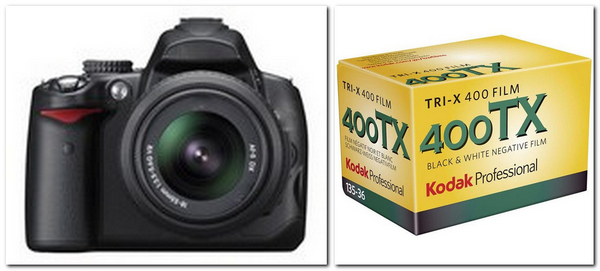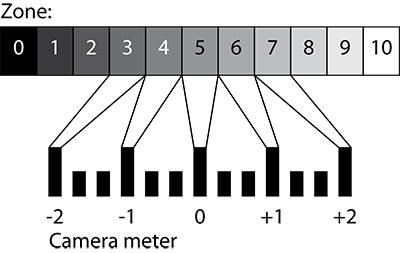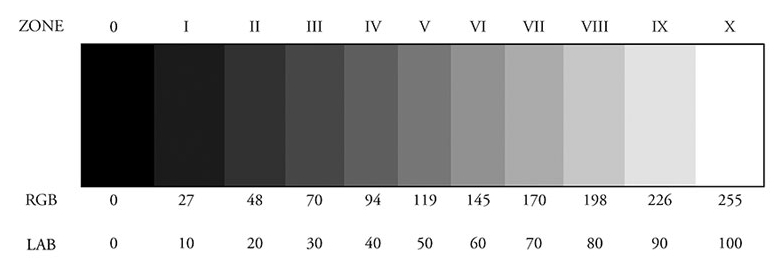Calibrating your meter, camera and film
The ISO # is an international standard that should make cameras, films, sensors, shutters and apertures give you the correct
exposure.
We know that your exposure determines the shadow areas of your negative, development determines the contrast.
Exposures can be divided up into steps of tone from black to white or clear film to dense film. These steps (zones) are broken up
into divisions of one "stop" of exposure. This is often refered to as changes in film densities.
Meters (and ISO) are designed to give a middle gray exposure.
They might not be accurate. This test is a check to see if this is
true for your meter and film. If necessary we can correct this by simply setting our meter to a "custom" iso.
Film speed is determined by the exposure that reaches the first hint of shadow detail (Zone 1 density on the film.)
Clear film should give "maximum black" Shadow detail is the first hint of density
This test is simply metering a test target and bracketing exposures above and below the metered settings, set to give us zone
one.
In Class- shoot for calibration:
Expose Test Film
The target you photograph should be smooth toned, evenly lit, neutral in color and large enough to fill the frame.
Set
your meter to the manufacturers film speed (iso#) or ASA.
Point your camera at the subject and set the lens and shutter to give the recommended exposure.
Choose a shutter speed that requires an f/stop of approximately f/4or f/5.6
1- Make your first exposure at this camera setting ~ this will be middle gray Zone 5.
f/stop____ Shutter 1/_______
2- Make your second exposure
Close your lens 4 stops- (count 4 full stops - this should be Zone 1 f/stop____ S 1/_______
3) Make 4 more exposures:
Bracket the second exposure (Zone 1) in half stop increments - record the exposures (
+ 1f/________ full stop more exposure
+ 2 f/_______ 2 stops more exposure
-1/_________ full stop less exposure
- 2f/________ 2 stops less exposure
Develop and Evaluate
Develop the roll normally-
Evaluate for the frame that is the true Zone 1 exposure (first hint of gray
on the film)tone above clear film.
This frame indicates your calibrated film speed for your
camera, lens and meter.
If the second exposure (four stops under the meter for zone one) is correct, you use the
film speed recommended by the manufacturer.
- ½f stop is correct, increases the iso# (400 speed film goes to 600)
- 1f stop doubles the iso (400 speed film goes to 800)
+ ½ f stop reduces the iso (400 speed film goes to 300)
+1 f stop reduces the iso by half (400 speed film goes to 200)

First Roll Film Shoot PDF Checklist:
Try to consider design, look for good lighting, shadows, fill the frame.
After shooting the film test in class, the remainder can be shot in any order- indicate the frame number in the box.
Indoor shots may need a tripod or other camera support.
This is roll # 1 Film Type______________
Film Speed (ISO)___________
In Class shots #1-5 Exposure test for Black White and Gray
Shoot at least one each of the following images
Outside shot in sunlight:- sun at your back Sunny 16 exposure
ISO 400= F16 at 1/500
Moving subject fast shutter speed (freeze motion)
Moving subject slow shutter speed (blur motion)
(you need tripod or camera support for this)
Deep depth of field
Shallow Depth of field
Night shot long exposure with camera on tripod
Close-up image
Portrait
Self Portrait in mirror
Image in strong directional light
Image in flat low contrast light
Finish the roll with any other subjects you choose
Fill Out Evaluation Form

